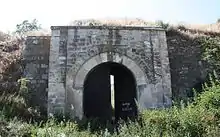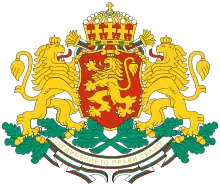Nikopol, Bulgaria
Nikopol (Bulgarian: Никопол [niˈkɔpoɫ]; historically Turkish: Niğbolu, Greek: Νικόπολις, Nikópolis, Romanian: Nicopole, Latin: Nicopolis) is a town in northern Bulgaria, the administrative center of Nikopol Municipality, part of Pleven Province, on the right bank of the Danube river, 4 kilometres (2 miles) downstream from the mouth of the Osam river. It spreads at the foot of steep chalk cliffs along the Danube and up a narrow valley. As of December 2009, the town has a population of 3,892 inhabitants.[1]
Nikopol
Никопол | |
|---|---|
City | |
 View of Nikopol from the fortress | |
 Nikopol Location of Nikopol within Bulgaria | |
| Coordinates: 43°42′N 24°54′E | |
| Country | Bulgaria |
| Province | Pleven |
| Municipality | Nikopol |
| Government | |
| • Mayor | Ivelin Savov (BSP) |
| Area | |
| • Total | 35.185 km2 (13.585 sq mi) |
| Elevation | 179 m (587 ft) |
| Population (2018) | |
| • Total | 2,882 |
| • Density | 82/km2 (210/sq mi) |




History
In Roman times, it was a village in the province of Moesia, first mentioned in 169. After the decline of the Roman Empire, the town turned out to be located at the northern border of the Byzantine Empire. In 1059, it was named Nicopolis, Greek for "City of Victory". During most of the Middle Ages, it was part of the Bulgarian Empire from its foundation in 681. After the fall of Tarnovo in 1393, the last Bulgarian Tsar Ivan Shishman defended what remained of the Empire from the fortress of Nikopol, where he was captured after the town was conquered by the Ottomans in 1395. Nikopol is therefore sometimes considered the capital of Bulgaria during these two years.[2] It was the site of the Battle of Nicopolis, the last large-scale crusade of the Middle Ages, in 1396. At the fortress of Nicopolis, the united armies of Christian Europe headed by Hungarian king Sigismund and various French knights were defeated by the Ottomans under Bayezid I and his Serbian vassal Stefan Lazarević.

Under Ottoman rule, Nikopol developed into an important military and administrative centre as a sanjak, with a strong fortress and a flourishing economic, spiritual and political life, until it went into decline during the 17th and 18th centuries. It was the centre of a district (kaza), but it was overtaken by Pleven as the regional centre of that part of the Bulgarian lands. Nikopol was captured by the Russians in the Battle of Nikopol in 1877.
Modern times
Nikopol has a population of 3,892 as of December 2009.[1] It is the seat of Nikopol municipality and provides services to the local villages. Nikopol was partially flooded by the Danube during the 2006 European floods, and is currently working on new town infrastructure to manage fluctuations in the Danube River.

The completion of a car ferry in 2010 has linked the town to Turnu Măgurele across the Danube in Romania, spurring local development, including the opening of new restaurants and the town’s first hotel. Nikopol also serves as a port for tourist boats where visitors stop and have the opportunity to take a bus into the nearby city of Pleven, or spend the afternoon in Nikopol.
The fifth-largest nature park in Bulgaria, Persina Natural Park, lies partially in Nikopol. Persina Natural Park is the only Bulgarian natural park on the Danube River, and contains marshlands, over 200 species of birds, 475 species of plants, and 1,100 species of animals. Based on the importance and uniqueness, Persina Natural Park has been declared a Ramsar site.
Tourist attractions in Nikopol include the ruins of the medieval fortress, the richly decorated 13th- or 14th-century Church of Saints Peter and Paul, the rock-hewn Church of Saint Stephen, the Bulgarian National Revival Church of the Dormition of the Mother of God from 1840, the Elia water fountain with an immured Ancient Roman gravestone featuring an epitaph, and the Vasil Levski museum house.[3]
International relations
Notable figures associated with Nikopol
 Ivan Shishman of Bulgaria, the last emperor of the Second Bulgarian Empire, beheaded at Nikopol in 1395
Ivan Shishman of Bulgaria, the last emperor of the Second Bulgarian Empire, beheaded at Nikopol in 1395 Jean de Vienne, French general and knight (1341 – 1396), died at Nikopol
Jean de Vienne, French general and knight (1341 – 1396), died at Nikopol Jean de Carrouges, French knight (1330s – 1396), died at Nikopol
Jean de Carrouges, French knight (1330s – 1396), died at Nikopol- Eve Frank, born at Nikopol (1754–1816), successor of her father, the Jewish claimed Messiah Jacob Frank.
- Joseph Karo, lived in Nikopol from 1523-1536
Honour
Nikopol Point on Livingston Island in the South Shetland Islands, Antarctica, is named after Nikopol.
References
- (in English) Bulgarian National Statistical Institute - towns in 2009 Archived November 13, 2010, at the Wayback Machine
- Map in the National Historical Museum (Bulgaria)
- "Културно-историческо наследство" (in Bulgarian). Община Никопол. Retrieved 27 September 2010.
- "Lista municipiilor înfrățite din România" [List of municipality twinnings in Romania] (in Romanian). Archived from the original on 2009-09-01. Retrieved 2017-01-29.
External links
| Wikimedia Commons has media related to Nikopol. |
